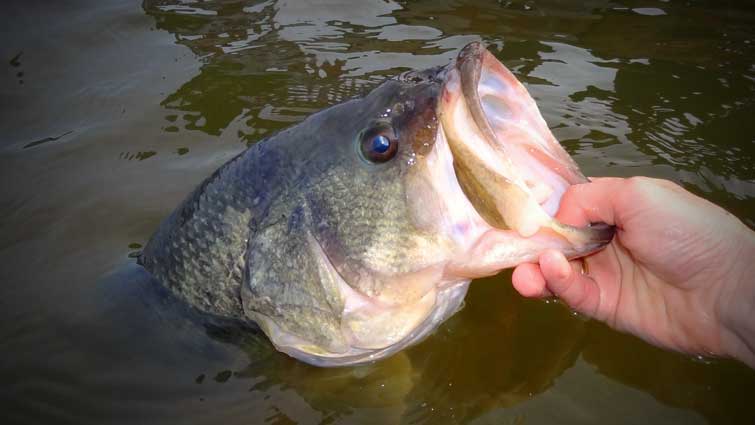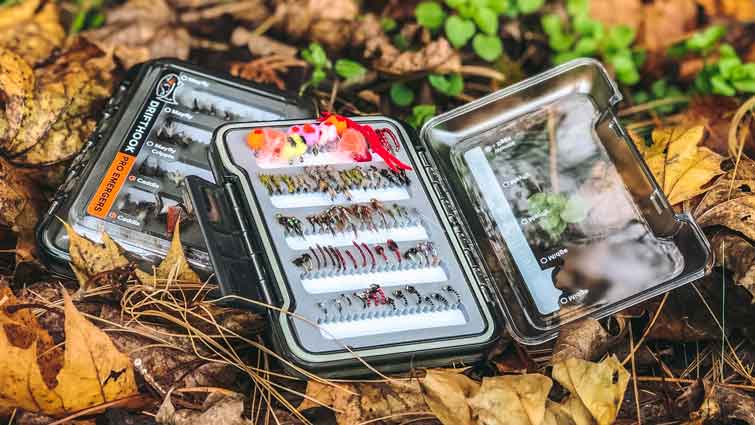Bass Fly Fishing offer anglers many benefits that may not be known to everyone, such as incredible top-water action, massive fish, and intense fights. Below there's an informative article about how to catch a bass on a fly every time successfully.

Can you catch bass on a fly?
As a general rule, it is possible to catch Bass on a fly rod. Fly fishing for Bass has become extremely popular in the last few years with the expansion of fly fishing worldwide. Specific techniques and gear have been developed to help anglers target all Bass and warm water species.
With the right tools and equipment, anyone can catch a bass with a fly rod, this includes:
Fly Rod
A regular 6-weight trout rod can be used with no problem, but for those who want a rod specifically dedicated to catching bass on a fly, an 8-weight one is recommended.

Flies
Flies might vary depending on the size of the rod, but generally, having a few minnow streamer patterns and some frog imitation poppers will ensure success on the water.

Reels
An adjustable drag system is highly recommended to catch bass on a fly, preferably a larger arbor reel as well, in a size similar to the chosen rod weight.

Fly Lines
Weight-forward fly lines with a compacted head are a great choice to overcome large and resistant wind patterns in most cases. Fly-fishing for bass from a boat on deeper lakes and rivers and intermediate sink tip or full sinking line is advisable.

Leaders and Tippet
A regular 4-8' fluorocarbon leader or section of tippet, about a few feet of a 10-20 pound tippet, will indeed work excellent for catching bass on a fly.
Largemouth and smallmouth bass can be found in almost every country's river, pond, and lake, offering excellent and hard-fighting battles. Below, more valuable and detailed information about catching bass with a fly will ensure a great adventure.

Tips To Catch Bass On A Fly Every Time
According to Bassmaster, the economic impact of bass fishing in the United States, including economic output and indirect contributions, is more than $115 billion each year, making the fishing industry one of the strongest sports-related industries in the country.
It is not as hard as it might look to catch a bass on a fly. However, there are some valuable suggestions to have in mind to ensure a fantastic fishing time.

To begin, a tactic worth implementing to catch a bass relies on acting like one. Writer and publisher of Wayward Fly Fishing, Toney Sisk, expressed that "Fishing for bass inclines you to stalk them like they stalk their prey" further explaining the difference between bass and trout that people tend to take as equal. "They (trout) don't have the explosive body/muscle type that makes a bass attack like a linebacker through the weeds and into their prey."
Observing the water and being aware of the environment are crucial elements to catching bass with a fly.
Another suggestion lies within casting big flies, to which Sisk shared his opinion on the topic by writing, "Deer hair is the ideal material for bass bugs because of the size of the bugs you can create and the endless variety of ways to trim the fly to suit your casting." To figure out which fly size to cast with a relatively light line, it is recommended to tie some bass bugs and have a pair of fly tying scissors at hand, so once the bugs are on the water, they can be trimmed to the ideal size, always keeping the general dimensions of the original shape.
When it comes to the best and most appropriate weather conditions to catch a bass on a fly, many fly-fishers decide to go on windy days due to the salty options being too tough to fish, life members of United Fly Tyers, Rhody Fly Rodders, and founder of Crossroads Anglers, Armand Courchaine suggest spending time on pacific ponds with undisturbed waters. “The best bass fishing is always when the ponds are calm and quiet, especially on a cloudy day.”

How Do You Catch Bass On Flies?
A few things to expect when catching bass on flies must be addressed to cover all areas of the trip and activity.
Bass hits very hard and attact flies fiercely. There are, of course, exceptions to their behavior, but in general terms, fly-fishers are recommended to stay alert at all times.
Because bass has a much thicker skin than trout, it is essential to hook them securely by maneuvering a slightly robust set than a regular upwards flick of the wrist. The fish (especially Smallmouth) will likely jump once it has been caught, so keeping some line available to let it loose in this situation is highly advisable.
Catching bass requires patience and a long fight. They don't wear out as quickly as trout, and because of their dependency on specific water temperature and oxygen levels catching the fish will take some time and a good mix of maneuvers to conquer.
What Is A Good Line Weight for Bass Fly-fishing?
Most fly lines already provide basic specifications on their labels for the chosen line, and it is crucial to match the fly line weight with the rod weight to ensure balanced, reliable fly fishing performance.
According to Scientific Anglers, a good line weight for bass fly-fishing would involve a 7/8/9 weight line with a WF taper, followed by an 8 lb - 12 lb leader/tippet and a 7/8/9 size reel with a disc drag system. The rod should have a 7/8/9 weight and have a length of 8.5′ - 9.5′.
Which Fly Is The Best To Catch Bass?
Director of Brand Partnerships at Flylords Wills Donaldson has some suggestions according to the best types of fly to use when catching bass, stating that "It's not about the specific flies, but instead about their presentation."
Colorful and shiny elements presented on flies count for a great tool to catch a bass’ attention. Sparkly and attractive elements take the bass out of their hidden spot and are perfect for murky pond waters.
Poppers are another excellent and effective element to successfully catch bass because they were built to replicate movement from large top-water animals, usually frogs.
Weighted flies increment the chances of getting them into the bass' feeding lane. Donaldson explained that "These flies are especially useful in the late summer as fish are hunkered down in deeper water in attempts to stay cool. Using heavy flies is also an important aspect when fishing big moving water, as it assures you that your fly will spend less time sinking and more time looking delicious".
When asked about the amount of movement a fly should have, Wills further stated, "Flies with moving parts is just another way to get the attention of apathetic fish. By using zonkers, rubber legs, or articulation, the bass is more likely to fall into the hypnotic daze an easy meal presents".
What Gear Should I Take Fly Fishing for Bass?
Life-long fisherman Tim Butala suggests some specific tools and equipment take fishing, which may vary depending on the time of the year, but generally rely on the same:
- Rod and Reel
- Flashlight/Headlamp
- Extra Batteries
- Hat and Sunglasses
- Sunscreen
- Waders and Wading Boots
- Hip or Chest Pack
- Bug Spray
- Binoculars
Then, of course, the chosen smaller supplies such as flies, nets, sinking tip line, wading boots, and more.
Is There More Than One Type Of Bass?
Yes, there are multiple types of bass, including:
- Smallmouth bass: that features a vertical barring on each side and has a skin color between brown and green with a white belly.
- Largemouth bass: which feature lateral stripe
- Guadalupe, Alabama, and Spotted bass: that differentiate themselves from the rest by having an irregular lateral stripe with spots on the scales that create rows of white stripes on the belly.
- Hybrid Striped Bass: that have broken and distinct stripes that extend to the tail
Conclusion
Fly-fishing for bass is a life-changing and incredible adventure that more and more fisher enthusiasts are beginning to try. With minor and regular equipment needed, everyone can try to catch a bass with a fly.
There are a few things to have in mind in terms of gear (such as the size of the rod, the reels, fly lines, as well as the fly themselves) to ensure a quality experience and a great catch, along with the appropriate weather to go fishing, that is crucial to the practice.
Many fishermen decide to experiment with different techniques and equipment and openly express their content with the results. Creativity is always a good skill to implement on the pond. Being constantly alert while fishing for bass is another essential ability because any sudden movement in the environment can cause the fish to go away or jump out of the water when caught.
Those fly-fishing for bass must have patience and should expect a great and long-lasting battle with the fish. They are more vigorous and more violent than trout, and therefore practicing different maneuvers or being ready to do so is highly advisable.
Experts recommend calm and peaceful waters to fly-fish bass, with tranquil waters, especially on a cloudy day or when there's not much daylight (either very early in the morning or when the sun is setting).
Sources
- Montgomery, Robert. “Report shows U.S. anglers have $115 billion annual impact.” Bassmaster, 24 January 2016.
- Sisk, Toney J. “Bass on a Fly.” Midcurrent.
- Barrett, Pete. “Fly Fishing for Largemouth Bass.” On The Water, 6 April 2020.
- Scientific Anglers. “PUTTING TOGETHER A BALANCED FLY FISHING SYSTEM.”
- Donaldson, Wills. “Fly Fishing for Smallmouth/Largemouth Bass: Your Complete Guide.” Flylords, 11 November 2019.
- Butala, Tim. “Fly Fishing for Bass: 21 Tips That Help Me Catch More!” Outdoor Troop.

About the Author
Matthew Bernhardt, a third-generation Coloradan, grew up at the forefront of the state’s fly-fishing revolution, enjoying time on the water, side by side with experienced guides and lifelong anglers.
By combining his passion for fly-fishing with input from other experienced fly-fishers and guides and his fine arts degree from Colorado State University, Matthew spent five years carefully developing the Drifthook Fly Fishing System, built to help every angler catch more trout.
When he’s not spending time with his wonderful family, you’ll find him out on the water catching MONSTER trout, and he anxiously looks forward to the day when his kids are old enough to join him there.




